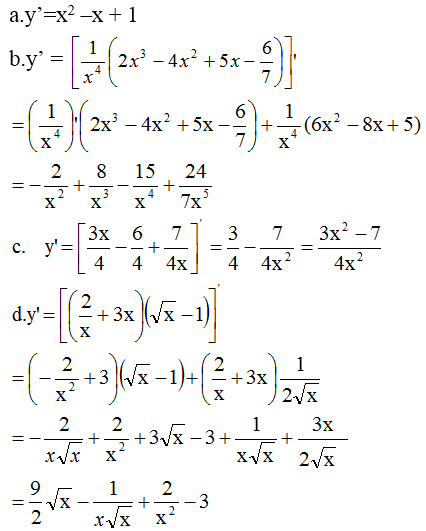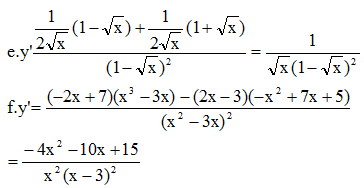Hãy nhập câu hỏi của bạn vào đây, nếu là tài khoản VIP, bạn sẽ được ưu tiên trả lời.

\(y'=1+\dfrac{1}{2\sqrt{x^2+x}}\left(2x+1\right)\)
\(\Rightarrow xy'=x+\dfrac{2x^2+x}{2\sqrt{x^2+x}}>x+\sqrt{x+x^2}\)
\(\Leftrightarrow\dfrac{2x^2+x}{2\sqrt{x^2+x}}>\sqrt{x^2+x}\Leftrightarrow2x^2+x>2\left(x^2+x\right)\Leftrightarrow2x^2+x>2x^2+2x\Leftrightarrow x< 0\)
\(\Rightarrow S=\left(-\infty;0\right)\)

a) \(y=\sqrt{1-sin\left(x^2\right)}-1\) đạt giá trị lớn nhất là 1 , giá trị nhỏ nhất là - 1 ( để ý rằng u = x + \(\frac{\pi}{3}\) lấy mọi giá trị thực tùy ý khi x thay đổi ) , nên hàm số y = 2cos \(\left(x+\frac{\pi}{3}\right)\) + 3 đạt giá trị lớn nhất là y = 2 . 1 + 3 = 5 , giá trị nhỏ nhất là y = 2 . ( - 1 ) + 3 = 1
b) Hàm số y = 4sin |x| = đạt giá trị lớn nhất là 4 ( khi sin | x | = 1 tức là | x | = \(\frac{\pi}{2}\) + 2k\(\pi\) , k nguyên không âm ) , đạt giá trị nhỏ nhất - 4 ( khi sin | x | = \(-\frac{\pi}{2}+2k\pi\) , k nguyên dương )


y' > 0 ⇔ \(\dfrac{-1}{2\sqrt{4-x}}+\dfrac{1}{2\sqrt{4+x}}>0\)
⇔ \(\dfrac{1}{2\sqrt{4+x}}>\dfrac{1}{2\sqrt{4-x}}\)
⇔ \(\dfrac{1}{\sqrt{4+x}}>\dfrac{1}{\sqrt{4-x}}\)
⇔ \(\left\{{}\begin{matrix}4-x>0\\4+x>0\\4+x< 4-x\end{matrix}\right.\)
⇔ \(\left\{{}\begin{matrix}4-x>0\\4+x>0\\x< 0\end{matrix}\right.\) ⇔ -4 < x < 0.
Bạn thêm dấu = ở số 0 vào nhé